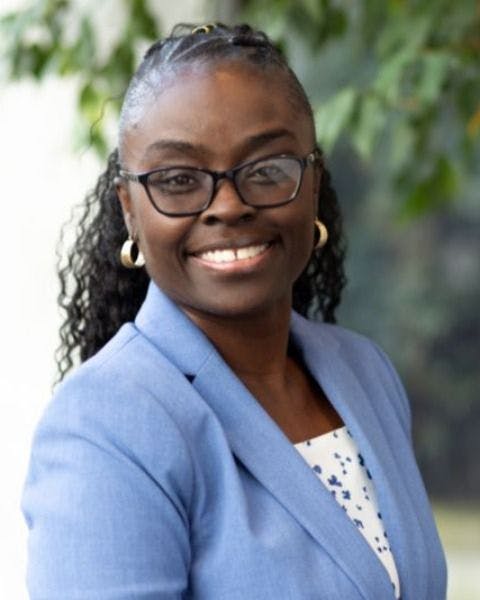SDOH in Cancer Care Highlight Multifactorial Equity Issues
12/07/2023, The American Journal of Managed Care

What are social determinants of health (SDOH) and why are they important? What are multilevel barriers to addressing social risks? How can we best utilize SDOH data? A trio of experts set out to answer these and other questions by addressing the multiple fronts on which SDOH have an impact on the cancer care continuum—community, social services, and individual health care needs—on day 1 of the 46th annual San Antonio Breast Cancer Symposium.

“How can we work together to come up with a framework that is culturally sensitive to all of our communities,” asked Amelie Ramirez, DrPH, MPH, chair of population health sciences at UT Health San Antonio and associate director for community outreach and engagement, Mays Cancer Center. “At the same time, how can we ensure we are meeting the needs of our patients so that we can truly improve their experience as they’re going through cancer or some other chronic illness?”
In many cases, she noted, people are now wondering if ZIP code is as important as genetic code, with increasing research showing that our health is influenced by factors beyond the medical. Four areas of San Antonio that she highlighted—Balcones Heights, Alamo Heights, Prospect Hill, and Dignowity Hill—denote stark differences from neighborhoods only a few miles apart. For example, Balcones Heights’ population is 81% Latino with an average annual income of $31,000 vs 18% in Alamo Heights with an annual income of $111,000. And in Prospect Hill, the 95% Latino population has an average annual income of $27,000 vs $35,000 among the 70% Latino population of Dignowity Hill.
Data from a 2018 analysis by the Kaiser Family Foundation that Ramirez cited showed poverty, financial stress, and lack of affordable health insurance and medications affect more Black, Hispanic, and American Indian/Alaska Native individuals than White and Asian individuals. Additional social needs that affect health care and cancer-related outcomes among minority populations include inability to obtain healthy foods, have reliable transportation, and afford stable housing, and earning a low wage and having limited benefits, noted Ramirez.
The implications are lifetime disparities with downstream health effects, such as higher rates of obesity, asthma, diabetes, and heart disease, and a shorter overall lifespan among persons of color. Latino populations, in particular, have higher rates of liver, cervical, and stomach cancers vs the general population, Ramirez added.
With more than half of the US population expected to comprise people of color by 2050, according to 2017 data from the US Census Bureau, the need for SDOH screening and long-term strategies for change has never been more apparent to identify nonmedical barriers to health and social needs, by their root causes, Ramirez emphasized. Compassionate communication is a vital component of accomplishing this feat, she added, as is accepting that patients may not want to respond.
“We need our providers to be as sensitive as they can,” Ramirez concluded. “For them to work as a team to better understand the needs of our patients.”

Brenda A. Adjei, EdD, MPA, associate director for healthcare delivery and equity research, Office of Clinical Director, NCI Center for Cancer Research, continued the discussion by tackling multilevel barriers to addressing social risks through a lens of NCI data.
NCI, to this end, has focused its health care delivery work on identifying the adverse conditions associated with poor health to establish how health care systems and organizations can contribute to advancing health equity. Important here, Adjei noted, is ensuring that everyone who has cancer “has a fair and just opportunity to prevent, detect, receive quality care, and survive cancer with optimal quality of life.”
Knowing social risks matters to cancer care delivery, she added, because food insecurity and housing instability are more prevalent among patients with cancer, and their prevalence is higher among patients already experiencing disparities. The relationship is both dynamic, in that it changes over time, and bidirectional in that the hardships that patients with cancer face throughout their care can further lead to social risks that further exacerbate health care disparities.
Some examples are receipt of non–guideline concordant care; treatment nonadherence, delays, and interruptions; decreased quality of life; late-stage cancer diagnoses; and lower survival.
“But while health care systems are increasingly capturing and assessing and trying to think about how they assist patients with their social needs, there's limited evidence to really guide these efforts across various settings,” Adjei underscored. “Relatively little published research exists about how health care settings can effectively intervene to help identify and address social needs for patients.”
A 2019 report that she highlighted from the National Academies of Sciences, Engineering, and Medicine identified 5 key strategies for how to effectively integrate social care into health care delivery:
- Awareness: identifying social risks within patient populations
- Adjustment: using social risk data to inform care decisions
- Assistance: connecting patients with social care resources
- Alignment: understanding a community’s existing social care resources and deploying them
- Advocacy: promoting policies to improve availability and distribution of resources
NCI also conducted a survey from July to September 2021 meant to identify multilevel barriers to cancer care, research gaps, and recommendations for addressing social risks. Sixty-one NCI-Designated Cancer Centers and 46 NCI Community Oncology Research Programs were invited as of July 2021, and 90% completed the survey.
Among those experiencing food insecurity, housing instability, and/or transportation barriers—although overall, fewer barriers were reported for food insecurity vs the others—top clinician-/staff-level barriers to addressing social risks were insufficient time during clinic visits and clinicians not being informed/trained on how to connect patients with social resources; top organization-level barriers were inadequate staffing and limited/no infrastructure to systematically address social risks; and top community-level barriers included no community-based organizations and limited budgets to address social risks for patients and survivors.
Key takeaways include needs for social risk–oriented system-level interventions that address social risks across care delivery settings, tailoring interventions to meet the needs of diverse patient communities, and incorporating various stakeholder perspectives.
“We must support research initiatives that will generate evidence and guide the delivery of equitable cancer care across domains of research, practice, and policy,” Adjei emphasized.
The goal of Brian M. Rivers, PhD, MPH, professor and director of the Cancer Health Equity Institute at Morehouse School of Medicine, was to build on known definitions of SDOH in their relationship to disparate health outcomes and describe clinical strategies to address SDOH. Like Ramirez and Adjei, he emphasized cancer care disparities can be exacerbated by nonmedical barriers that are complex and interrelated.
According to HHS data he presented, an estimated 20% of health outcomes can be attributed to clinical care, but 50% of county-level variation in health outcomes is due to SDOH.
“We’re only starting to see an advancement of the science in terms of understanding, as it relates to having SDOH, such as poverty, or housing discrimination, and how it impacts social risk factors,” he said.
Using the National Institute of Minority Health and Health Disparities Research Framework, he demonstrated that the complex interplay between domains of influence and levels of influence has an impact on health outcomes, emphasizing that “any reasonable intervention” should encompass multiple domains (biological, health care system, sociocultural environment) and multiple levels of influence (individual, community, societal). Further, he noted how upstream factors (social conditions and policies, health care and economic systems, the media) can influence intermediate factors (social context, social relationships, physical environment, individual risk behaviors) and downstream factors (biological responses, biologic/genetic pathways), ultimately impacting one’s social needs.
The Grady Hospital case study he presented, “Advancing Healthcare Equity: Collaborative Strategies to Address Social Determinants of Health at Grady,” served as an additional example of this. Grady is a safety-net hospital in Atlanta, Georgia.
Approximately 30% of Grady’s patients are uninsured, and 27% each are on Medicaid or Medicare. Just 16% have commercial insurance. Food insecurity is the top health-related social need (25%), followed by lack of transportation (18%) and homelessness in the past year and difficulty paying for basics (17% each). In 2021, there were 2977 distress screenings.
Investigators came up with 3 potential collaborative solutions to address patients’ social needs: Seek local and national community partners, leverage technology, and leverage people. Registered nurse navigators alone were able to improve breast cancer treatment adherence by 14% in 2021 and number of encounters by 33%, registered dieticians help to provide nutrition education and connect patients to community food resources, and the Food as Medicine program addresses both food insecurity and chronic disease, “with benefits that extend to children, families, visitors, and staff."
“Health disparity is a multifactorial issue. We know there are contributions from the environmental, social, cultural, psychological, clinical, biological, genetic, and the behavioral spaces,” he expressed. “Anybody who wants to intervene on any of these disparate outcomes can not only just address one of these factors, but must address multiple factors.”
View More